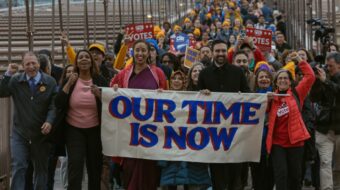
The goal for the Vietnamese Communist Party’s (CPV) 11th Party Congress was to “enhance the Party’s leadership capacity and combativeness, promoting the nation’s synergy, comprehensively boosting the doi moi (renovation) process, creating the fundamentals for Vietnam to basically become a modern-oriented industrial country by 2020.”
The gathering in Hanoi January 12-20 attracted little U.S. media coverage, no small irony given obsessive U.S. interest decades ago when millions died, U.S. society fractured, and advanced weaponry and a rich nation’s resources were turned against a nation of poor farmers.
At five year intervals, the CPV Congress chooses party leaders and determines short and long term national goals. This time, 1,377 delegates participated, representing 3.6 million CPV members, organized in 54,000 party units. Retired party leaders and foreign guests attended. A newly elected Central Committee, which meets twice yearly, replaced one third of the 17 person Political Bureau with younger members.
Retiring CPV Secretary General Nong Due Manh assured delegates of the nation’s “aspiration to establish its fundamental economic base of socialism with a superstructure of politics, ideology, and culture directed at building a prosperous nation.” Emphasizing scientific and technologic education, he called for a “socialist oriented market economy” with a “high sense of independence and self sufficiency.”
Documents submitted to the Congress included an updated “Draft Platform on National Construction in the Transitional Period toward Socialism,” a proposed “Socio-economic Development Strategy for 2011-2020,” and a report “reviewing the leadership and guidance of the 10th Party Central Committee.”
According to official news sources, discussion covered “the Vietnamese revolutionary process” and “fundamental directions in the process of socialist construction. Delegates “assessed the achievements, shortcomings, weaknesses, reasons, and lessons” stemming from previous strategies. They considered “directions for Party building in terms of ideological training, virtue, ethics, [and] improving Party members’ quality.”
For Political Bureau President Nguyen Minh Triet, opening the Congress, this was “a very crucial moment,” particularly because this was the 25th anniversary of “doi moi,” or renovation. That comprehensive program of political and economic changes has enabled socialist Vietnam to join capitalist oriented, international economic and financial networks. Review and reappraisal were due, he said.
Analyst Alberto Cruz cites present Vietnamese determination to maintain “social well-being,” provide employment through joint ventures with foreign corporations, and “protect the population [through] lines of credit for small and medium size businesses.”
Despite the world economic crisis, the country’s growth rate, maintained over recent years at an average 7.2 percent annual rate, fell only 37 percent. By contrast, Malaysia’s growth rate declined 137 percent and U.S. and Eurozone growth rates dropped 219 percent and 224 percent respectively. Over 10 years, Vietnam’s GDP and export yield have increased by factors of 3.5 and five, respectively. Average schooling is up almost two years per child since 1990. From 1970 on, life expectancy advanced 26 years. Per capita income is up threefold over 10 years. Severe poverty has fallen from 37.4 percent in 1998 to ten percent last year. CPV leaders are attempting to balance funding demands of large infrastructure projects with support for social, energy, and communications programs, which also entails some controversy.
Vietnam certainly has problems, among them widening inequalities despite the drop in poverty, corruption, high food prices and a serious trade deficit. There has been controversy about policies toward Chinese bauxite mines and the management of the state shipping industry. Some have suggested that the “socialist market” economic policies have led to a waning interest in Marxist teachings among the young. However, notwithstanding these difficulties, the Congress ended on a high note of optimism.
Prime Minister Nguyen Tran Dung was re nominated to his post, though the National Assembly must approve this in May. New faces in the national leadership will include CPV Secretary-General Nguyen Phu Trong, the former National Assembly head who helped engineer the Assembly’s recent rejection of a proposed Japanese designed high-speed railway from Hanoi to Ho Chi Minh City. Nyguyen Trong Sang was nominated as president of the country. The outgoing president and general secretary are retiring for age and health reasons.
Independence leader Ho Chi Minh, honored at the CPV Congress, long ago reflected on goals not met, battles not won. “If it cannot be done because there are too few people, let many join their efforts. If it cannot be completed by the present generation, it can be finished by the next.” Time and persistence will tell, he was saying.
Image: Communist Party of Vietnam’s website.









